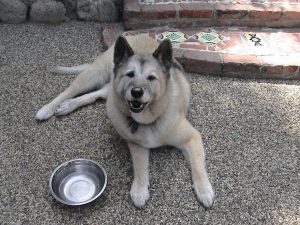 Water does a body good — canine, feline or human, and like the planet Earth, all 3 species are 3/4 water, so we all need a fresh supply daily.
Water does a body good — canine, feline or human, and like the planet Earth, all 3 species are 3/4 water, so we all need a fresh supply daily.
Dehydration — the lack of water in the body — is a serious condition that if left untreated can result in painful urinary stones, crystals & blockages, organ failure and death, so veterinary attention is a must! Water helps all the systems of the body function and remove toxins. Dehydration can occur when your pet isn’t drinking enough water, has been over-exposed to heat or is experiencing vomiting, diarrhea or a fever. Along with water loss, dehydration involves the loss of electrolytes – minerals like sodium, potassium and chloride.
Signs of dehydration include:
* Loss of elasticity in skin (Tugor Test – gently pulling up on skin at back of pet’s neck and seeing if it springs back in place within 1-2 seconds)
* Dry or sticky gums (feel carefully with your finger)
* Sunken eyes
* Slow CRT (Capillary Refill Time – the time it takes for color to return to your pet’s gums once you have pressed gently on gums and then removed your finger — it should be 2 seconds or less; look for pink in the lower eyelid of pets with dark gums)
* Lethargy
* Too much or too little urination
If you don’t know how to look for these signs, you need to bone-up on your pet parenting skills. A great place to start is by taking a Pet First Aid Class! Don’t wish you HAD known what to do or what signs to look for — it can make this difference between life and death for your best friend!
If you notice these signs in your pet, get to your veterinarian or Pet ER at once! Fluids will be administered sub-cutaneously (under the skin) or intravenously to most effectively re-hydrate him and get him on the road to recovery.
What you can do BEFOREHAND, however is pay attention to your pet during this chaotic season and always, making sure he stays well-hydrated so as to avert a problem. The cooler weather lessens the desire of most creatures to tank up on this life-giving liquid, so here are some ways to encourage good water drinking.

Cats are notoriously bad drinkers to begin with. Many felines however, are attracted to the sound or movement of running water. Fountains are available, but realize they need to be taken apart regularly and cleaned meticulously to prevent bacteria build-up. Running water in your sink will entice may send your cat running to it, so when you pass by, let a little flow and see if you can get her to drink several times daily. Other pet owners have found that by placing water bowls throughout the house, finicky cats are more likely to drink. They are also choosy about their bowls, some even prefer lapping out of mugs, can you believe? So try different sized ceramic and stainless steel types. If you find your cat will drink best from something that looks like what you also drink out of, you’ll have to set some boundaries so she doesn’t start sipping your morning joe. Adding a little tuna juice into their water might do the trick (Pour straight from the can or add 3 cups water to a can of tuna, pressing it well. Let sit for about 15 minutes and then strain and you can freeze the meat-less water into ice cube trays to safe for later). One other thought is to feed wet food (aka canned) as it comes with much-needed water already added. Kibble alone does not a healthy feline make.
For our other four-legged family members, our dogs…again, feeding wet food is a great start. Also the size and shape of the bowl may be a deal breaker (don’t you too have a favorite glass or cup?), so give a few a try (some deeper, some shallow, but stick to stainless or ceramic — never plastic which leeches chemicals into the water and can cause mouth sores). Every single day, wash that water bowl with warm, soapy water and rinse well. You wouldn’t after all, pour coffee into the unwashed mug you drank from yesterday, would you? Try adding a little cut-up fruit to their water (something they like obviously – blueberries, cranberries, apple slices) and they’ll get some water as they bob for the fruit. Adding a tiny bit of tuna juice, non-sodium chicken broth or other tasty liquid might also entice your dog to drink. Remember, canines can smell a spoonful of sugar in an Olympic-sized swimming pool of water, so it doesn’t take much for yours to know something tasty is mixed in there.
With the heat cranked up in our homes, the cooler weather outside (possibly meaning less exercise and exertion so less desire to drink) and even vomiting or diarrhea brought on by holiday stress, make sure your pets are getting all the life-giving liquid that their bodies need, and…remember his health is a priority even when you are busy decking the halls. Pay attention, notice your dog or cat’s bathroom habits and how full those bowls are remaining or draining.








